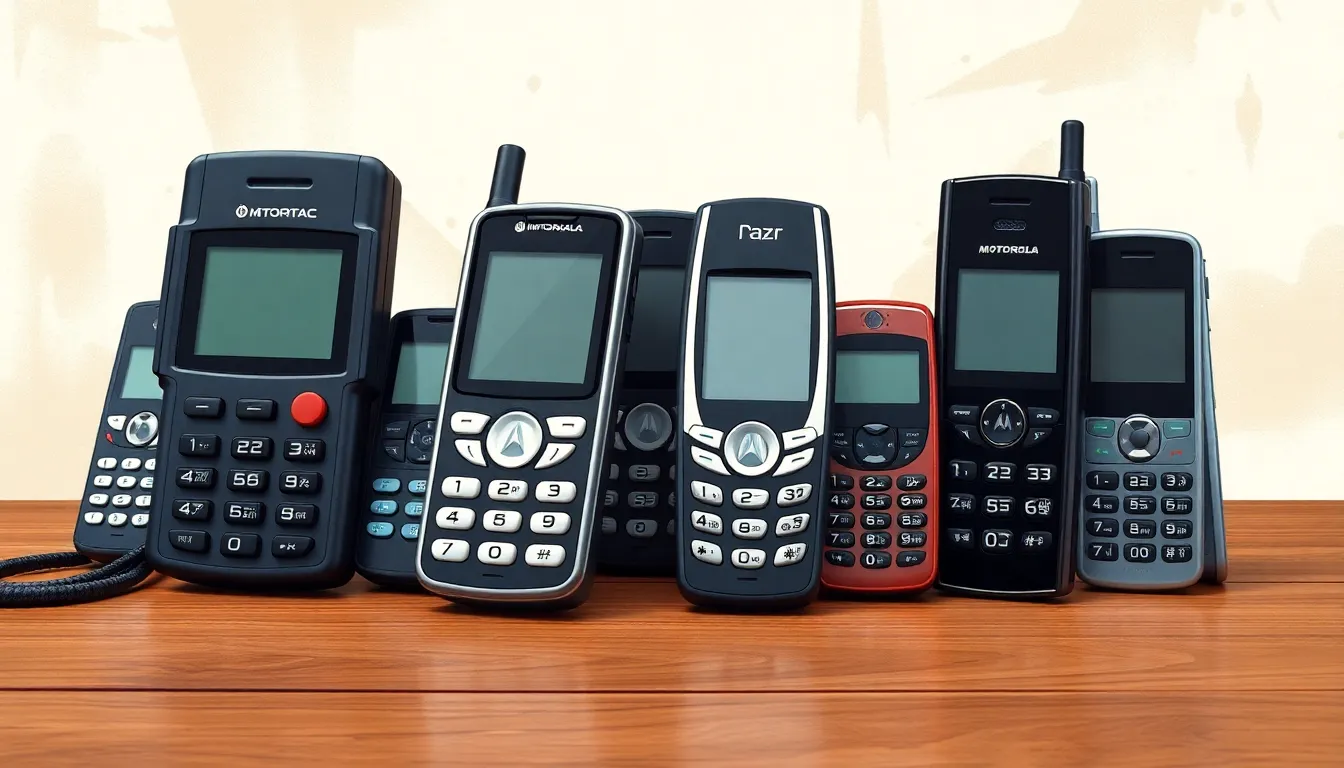Remember the days when cell phones were more like bricks than sleek gadgets? Those old school models, with their chunky designs and limited features, hold a special place in the hearts of many. They didn’t just make calls; they were the ultimate status symbols, often accompanied by a satisfying flip or a hearty antenna that could double as a self-defense weapon.
Table of Contents
ToggleThe Charm of Old School Old Cell Phones
Old school cell phones evoke nostalgia through their iconic designs and straightforward features. Users remember the weight of these devices, often compared to modern smartphones, for their substantial construction. Unique designs distinguished models from each other, showcasing vibrant colors and interesting shapes.
Each phone carried a personality, with some models featuring flip mechanisms that provided a satisfying snap when closed. Iconic devices like the Nokia 3310 offered durability and simple gameplay elements, making it a favorite among many. Users enjoyed long battery life, with some devices running for days on a single charge.
Familiarity grew among users as they navigated limited functionalities. Texting often involved strategic multitapping, turning messages into a test of patience and skill. Ringtones became a form of self-expression, with polyphonic options enabling fun personalization.
Old school phones served as status symbols, signifying one’s place in the social structure. Many users took pride in owning models like the Motorola Razr, which commanded attention with its sleek appearance. Collectors today recognize these phones as part of a larger cultural history, often showcasing them in dedicated collections.
Affordability played a significant role in the appeal of these devices. Prices remained accessible, allowing many to experience their charm without breaking the bank. The simplicity of old school phones attracts individuals seeking respite from the complexities of modern technology.
Iconic Models That Changed History

Old school cell phones feature several iconic models that significantly influenced mobile technology. These devices showcase unique designs and practical functionalities that resonate with nostalgia.
The Brick Phone Era
Brick phones dominated the early mobile landscape during the 1980s and early 1990s. Popular models like the Motorola DynaTAC 8000X set the standard for early mobile communications. Users appreciated their robust construction, often weighing over a pound. Battery life stood out, providing generous talk time compared to modern standards. Functionality revolved around basic communication, making them reliable options. Interestingly, the unique shape and size made them status symbols for professionals. Individuals flaunted their brick phones in boardrooms and gatherings, turning heads and sparking conversations. Remarkably, these phones laid the groundwork for future advancements in cellular technology.
The Flip Phone Revolution
The flip phone revolution began in the late 1990s, introducing a new wave of design and usability. The Motorola Razr became a cultural phenomenon, captivating users with its sleek profile and innovative clamshell design. Engineering emphasized portability, making it easy to fit into pockets. Users enjoyed the transition to a more compact form factor, which combined style with functionality. Features like internal displays and customizable ringtones fostered personalization. The texting experience improved with predictive text software, streamlining communication. This era marked a significant turning point, as flip phones became trendy artifacts of youth culture. Today, collectors celebrate these models as an important part of mobile history.
Features That Defined an Era
Old school cell phones showcased unique features that set them apart during their time. These devices combined functionality with character, establishing a memorable presence in the tech landscape.
Battery Life and Durability
Battery life represented a significant advantage. Many old cell phones offered days of use on a single charge, allowing users to rely on them without frequent recharging. Durability also became synonymous with these devices. Models like the Nokia 3310 could withstand drops and rough handling, often emerging unscathed. Users valued their phones’ build quality, as they felt secure in their ability to endure daily wear. Such robust construction generated trust, ensuring reliability in communication.
Basic Functionality vs. Today’s Smartphones
Basic functionality distinguished old cell phones from today’s smartphones. Early models focused on essential features like calling and texting without the complexities found in modern devices. Texting required multitapping, which many enjoyed for its challenge and uniqueness. Simplicity enhanced the user experience, allowing easy access to communication. The absence of distractions like social media and hundreds of apps led to more thoughtful interactions. Each phone’s charm lay in its straightforward purpose, making it an attractive choice for many users back then.
Nostalgia and Cultural Impact
Old school cell phones evoke a sense of nostalgia and cultural significance, shaping memories linked to early mobile technology.
Old School Cell Phones in Movies and Media
Old school cell phones frequently appear in films and television shows, representing specific eras and societal trends. Iconic models like the Nokia 3310 and Motorola Razr often symbolize youth and independence in character development. Viewers associate these devices with moments of connection and emotional exchanges. The portrayal of these phones not only reflects technological limitations but also relates to the time’s cultural values. Many notable films, such as “Legally Blonde,” feature characters using flip phones, emphasizing their role in everyday life during the early 2000s. Such instances highlight how these devices captured the spirit of the time while providing a nostalgic glimpse into past communication methods.
The Revival of Retro Technology
The revival of retro technology, including old school cell phones, fascinates collectors and enthusiasts alike. With limited editions of classic models re-emerging, companies cater to nostalgia-driven consumers. Retro designs appeal due to their simplicity and iconic aesthetics, often attracting individuals weary of complex smartphones. Many people appreciate the durability and longer battery life of these vintage devices compared to modern alternatives. This revival extends beyond functionality, tapping into cultural sentiments linked to earlier technology. Various events, like tech fairs, showcase classic phones, allowing people to reconnect with their past and celebrate the evolution of communication.
Old school cell phones hold a special place in the hearts of many. Their unique designs and straightforward functionalities evoke a sense of nostalgia that modern smartphones often lack. These devices were not just tools for communication; they represented a simpler time when technology focused on essentials.
As collectors and enthusiasts continue to celebrate these iconic models, the revival of retro technology highlights the lasting impact of these phones on culture. Each model tells a story of innovation and personal connection. The charm of old school cell phones reminds everyone of the joy in simplicity and the enduring appeal of classic designs.



